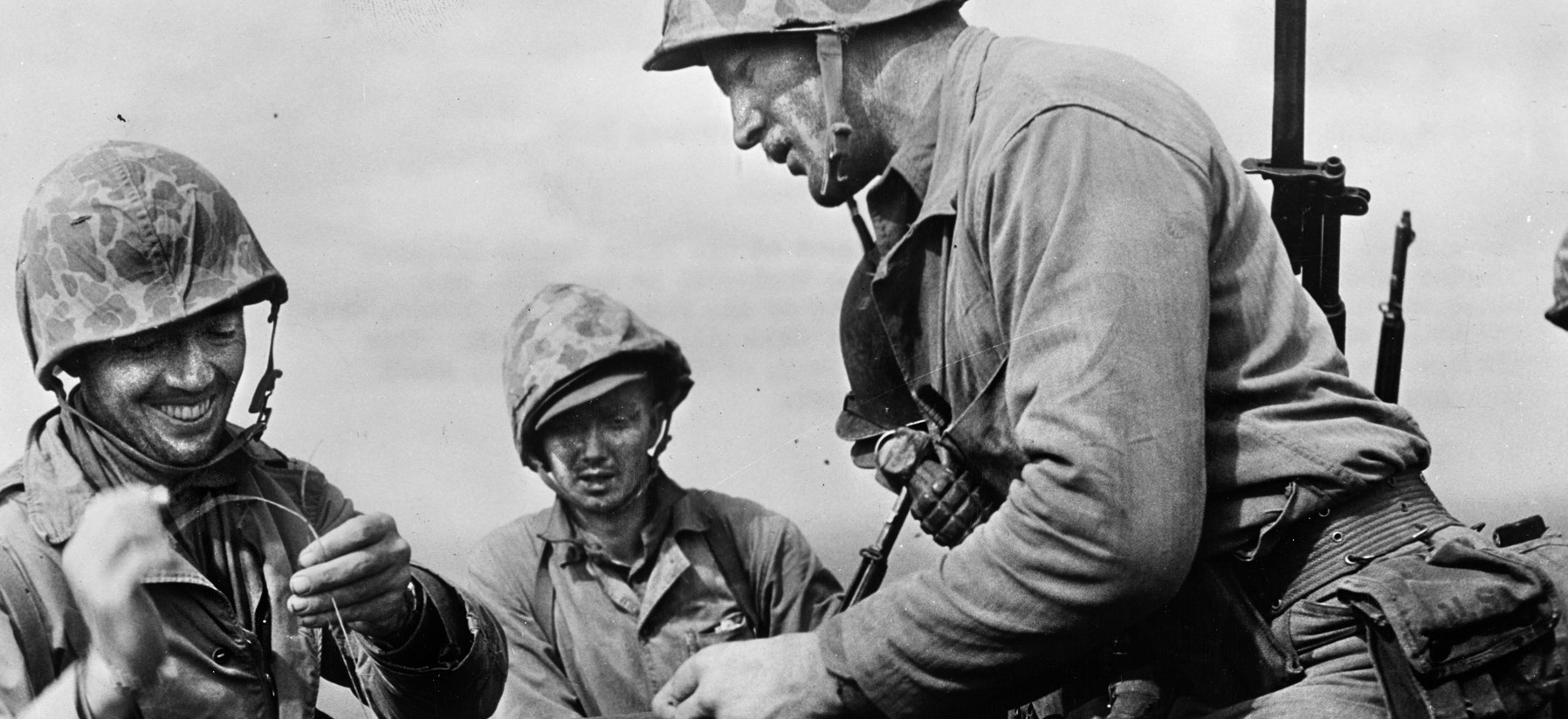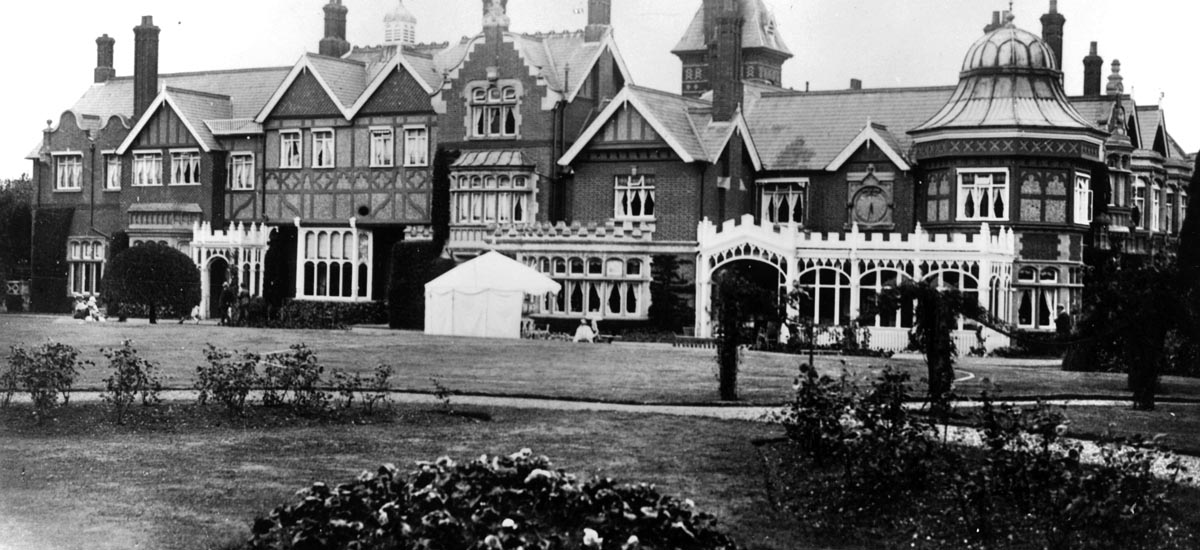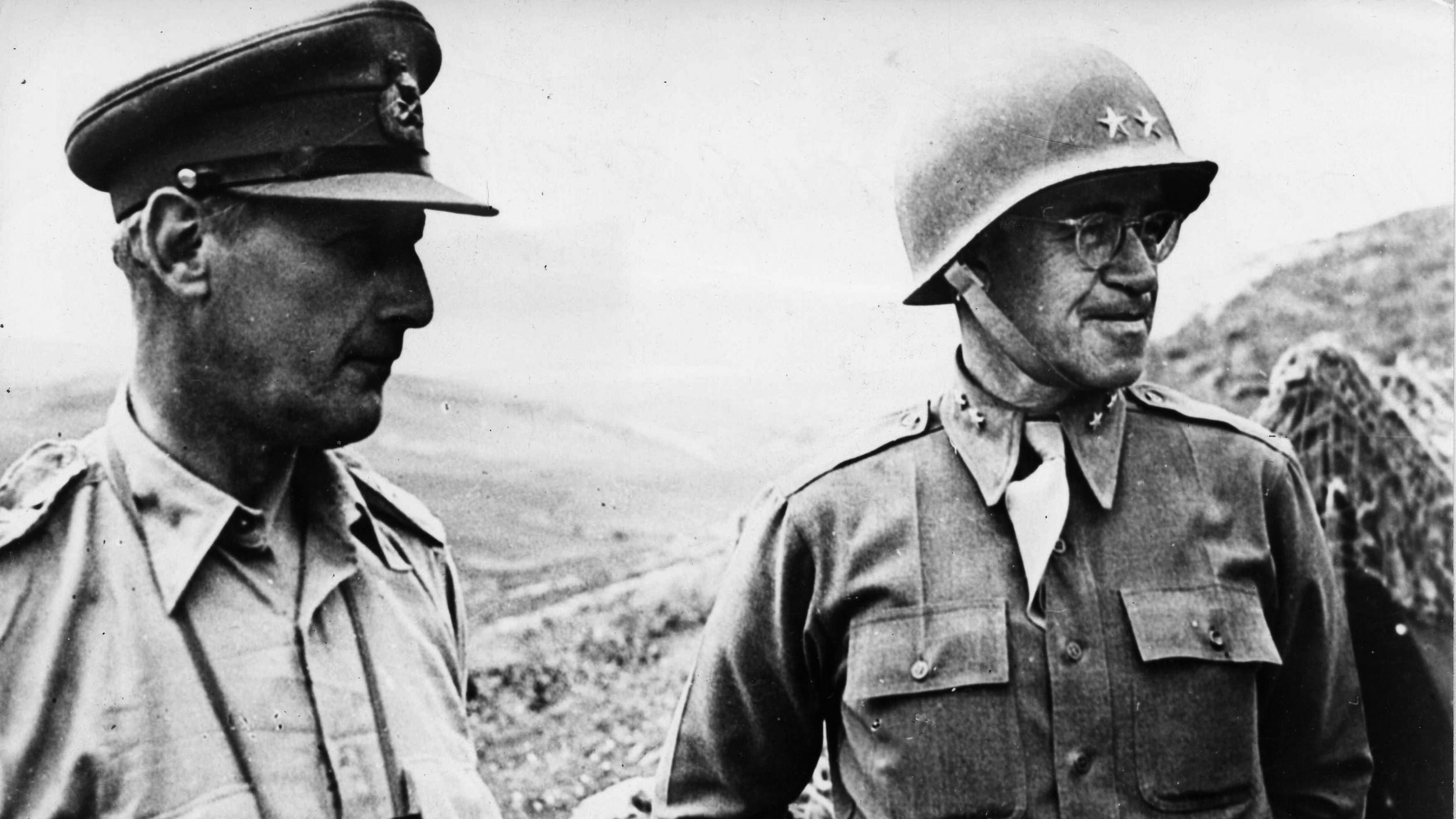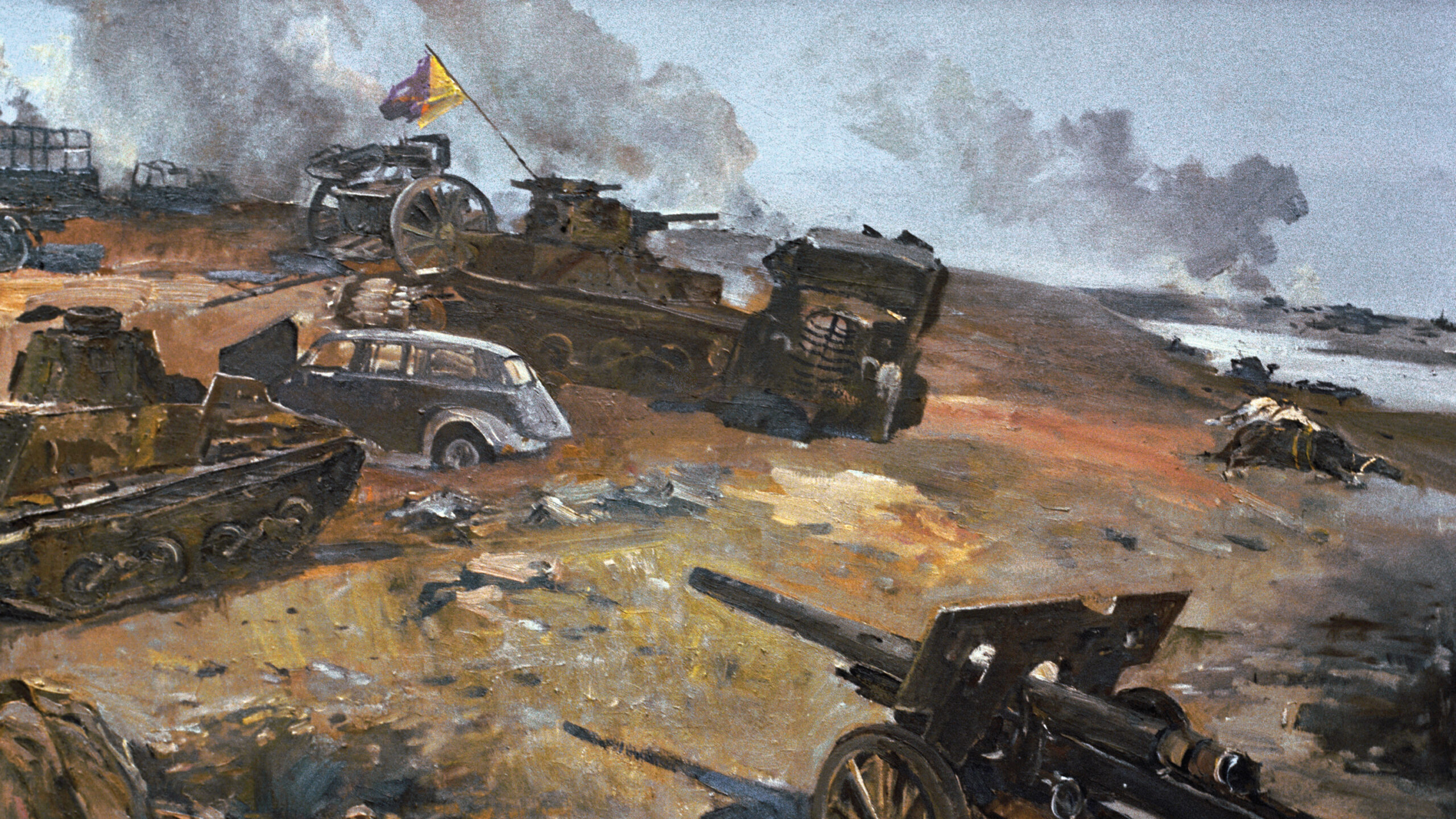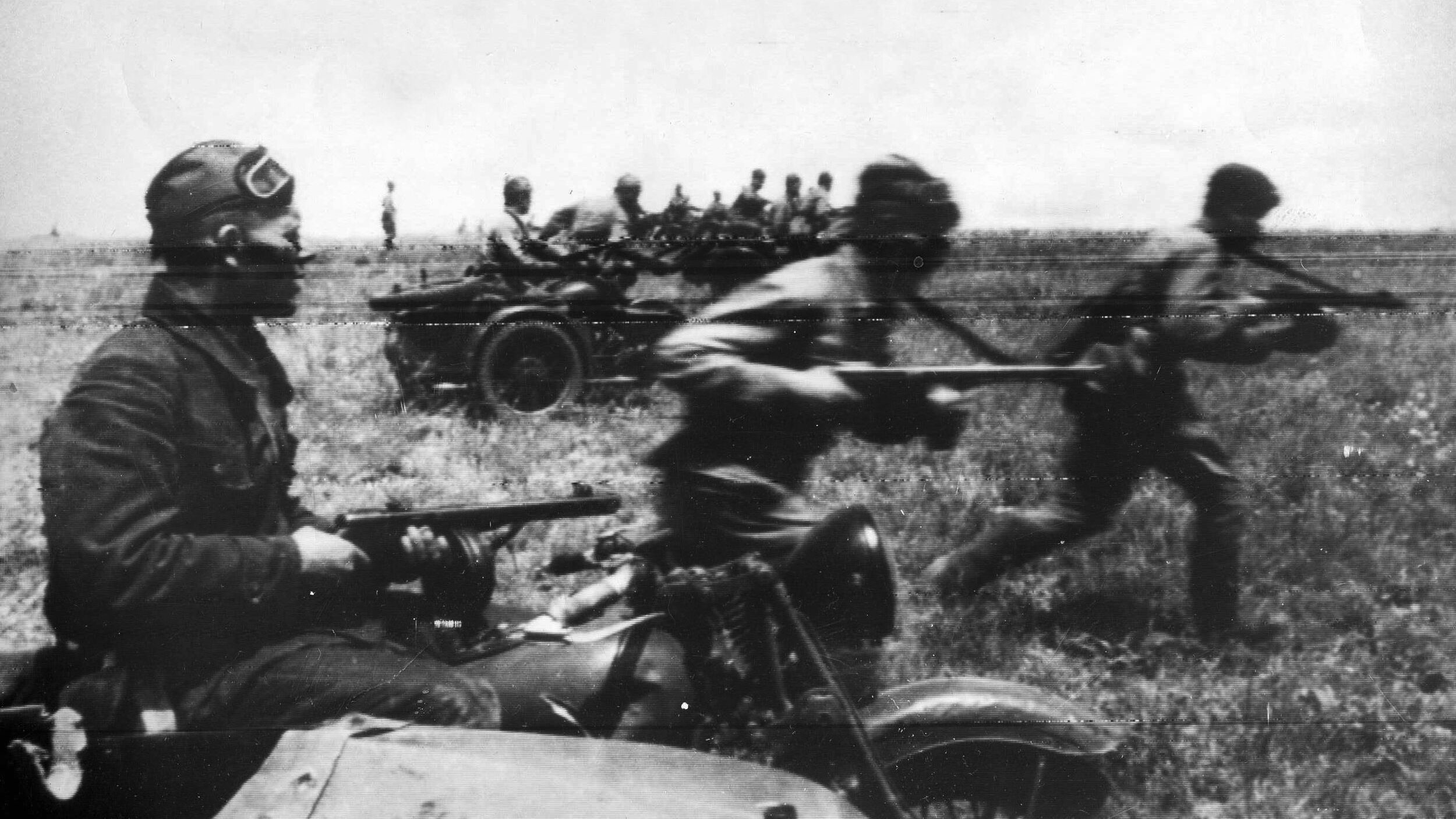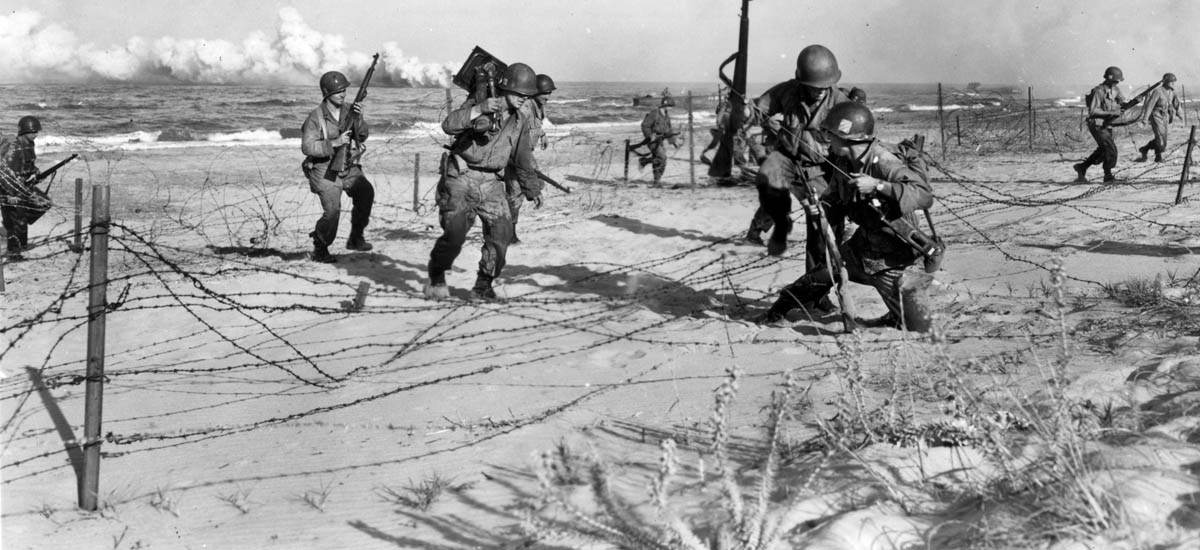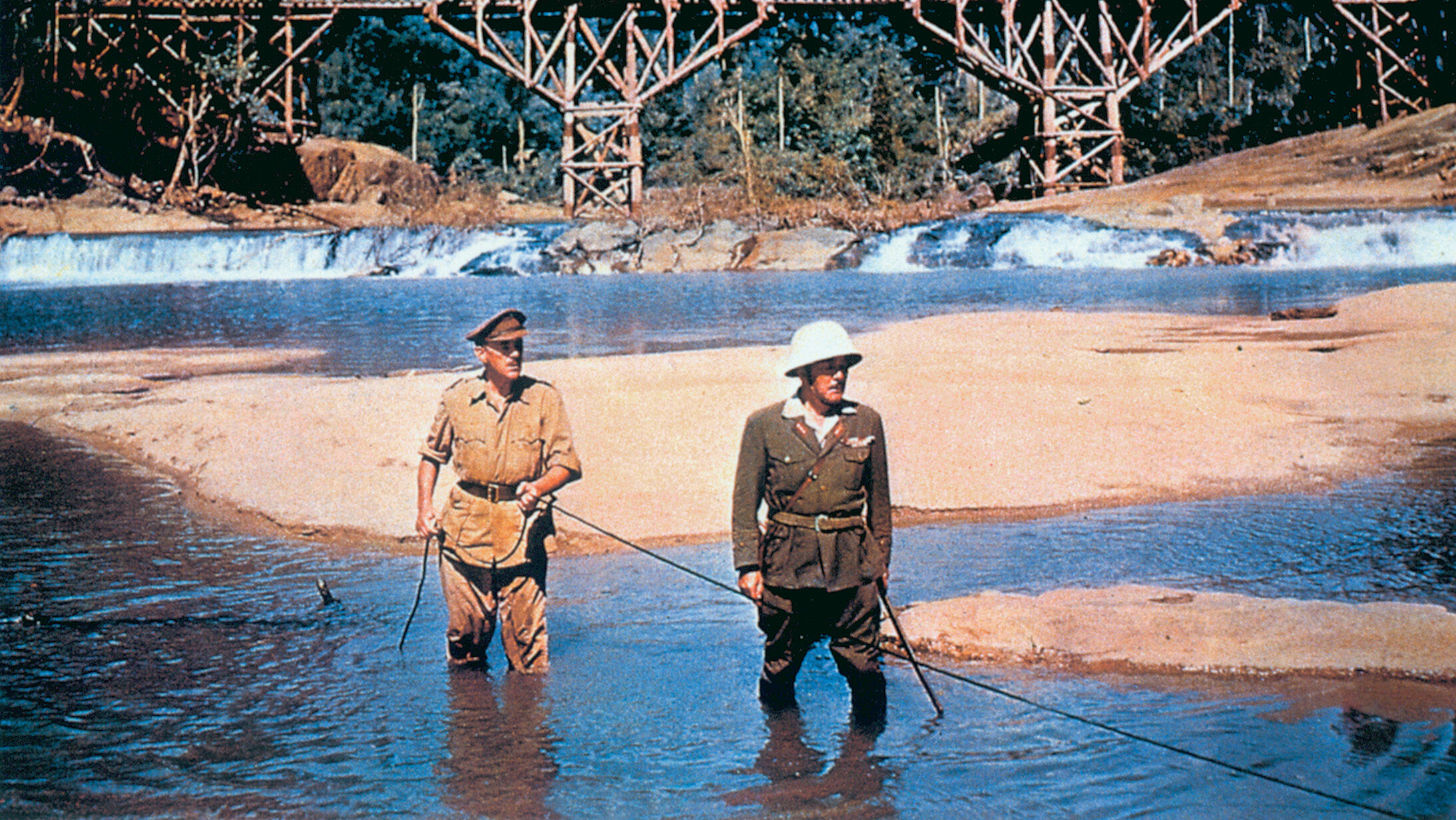By Christopher Miskimon
In the predawn darkness of February 23, 1945, a patrol went out toward the towering mass of Mount Suribachi. It was D+4, four days since the first invasion landings on the Japanese-held island of Iwo Jima took place, and the U.S. Marines who landed there had been fighting for their lives ever since. After days of struggle, the 28th Marine Regiment reached the base of the volcano and prepared to take it from the entrenched Japanese defenders. The Japanese occupied interconnected trenches, fighting positions, bunkers, and caves/tunnels that gave them a fortress-like position to repel attacks.
The first patrol included 15 men from two different squads of the 2nd Platoon, Company E. Pfc. Ira Hayes was one of the men selected. He went along with Sergeant Michael Strank, Corporal Harlon Block, Pfc. Franklin Sousley, and others. They set out from the company command post on the east side of Suribachi and made their way around to the south, winding up on the west side of the volcano. They encountered no Japanese at all. Counting their blessings for that, Ira recalled that the patrol simply returned to the command post to report.
 A second patrol went out at about 8 am. Four men of Company F led by Sergeant Sherman Watson set out to reach the summit. With no idea where the enemy might be, they climbed, hiked, and ran as fast as they could toward the heights of Suribachi. The slopes of the volcano are rocky and rough; enemy spiderholes or cave entrances would be invisible until a Marine was right upon one, and by then it might be too late to avoid a bullet, grenade, or bayonet. Still, they reached the top without enemy contact, finding an abandoned machine-gun position at the rim of the crater. Spare ammunition was still laid out neatly, ready for immediate use, but no one manned the gun. Blasted strongpoints and ruined equipment were everywhere, but no Japanese. The patrol headed back down.
A second patrol went out at about 8 am. Four men of Company F led by Sergeant Sherman Watson set out to reach the summit. With no idea where the enemy might be, they climbed, hiked, and ran as fast as they could toward the heights of Suribachi. The slopes of the volcano are rocky and rough; enemy spiderholes or cave entrances would be invisible until a Marine was right upon one, and by then it might be too late to avoid a bullet, grenade, or bayonet. Still, they reached the top without enemy contact, finding an abandoned machine-gun position at the rim of the crater. Spare ammunition was still laid out neatly, ready for immediate use, but no one manned the gun. Blasted strongpoints and ruined equipment were everywhere, but no Japanese. The patrol headed back down.
While that patrol was still out, battalion commander Chandler Johnson sent out two more patrols to find different routes to the summit. He also directed Company E’s commander, Captain Dave Severence to assemble a platoon-sized patrol to carry an American flag to the top. The flag was a 54-by-48-inch version received weeks earlier from their transport, the USS Missoula. Severence selected his 3rd Platoon, led by the company executive officer, 1st Lt. Harold Schrier. He led the men of the patrol to the command post for a pep talk from Johnson. As they moved out, Johnson gave the flag to Shrier, who tucked it down the front of his utility blouse. As Shrier turned to follow his men out on the patrol, Johnson called out to him. “If you get to the top, put it up,” he said. The patrol left on its climb.
The raising of the flag over Mount Suribachi is one of the most famous moments in American military history. The iconic photograph taken by correspondent Joe Rosenthal enables this moment to endure, but few know the photo depicts the second flag raising. There was a first flag, the one carried up by Shrier and his men. The recent book and Hollywood film Flags of Our Fathers cast light on this fact, but many still do not know the true story. That story is now available in detail in Two Flags Over Iwo Jima: Solving the Mystery of the U.S. Marine Corps’ Proudest Moment (Eric Hammel, Casemate Publishing, Havertown, PA, 2019, 175 pp., maps, photographs, appendices, notes, bibliography, index, $29.95, hardcover).
The author has written more than 50 books on military history, many of them focused on the Marine Corps and the Pacific War. This is a worthy addition to their ranks. The book is full of firsthand accounts with clear prose and an engaging narrative connecting them. The result is a book that keeps the reader’s interest throughout. There are many differences of opinion and mysteries surrounding the flag raisings, made murkier by the passage of time, the deaths of the participants, and a shortage of records common with combat situations. This book presents the facts as completely as possible and even includes the original Marine Corps investigation findings in the appendices. It is also well illustrated with images of the Marines involved and scenes of the fighting around the famous flag raisings. The book is part history and part detective story. It sheds worthy light on the men who raised both flags amid the carnage of one of the war’s most difficult and bloody battles.
 The Night Witches (Garth Ennis and Russ Braun, Dead Reckoning/Naval Institute Press, Annapolis, MD, 2019, 256 pp., illustrated, $24.95, softcover)
The Night Witches (Garth Ennis and Russ Braun, Dead Reckoning/Naval Institute Press, Annapolis, MD, 2019, 256 pp., illustrated, $24.95, softcover)
In mid-1941 the German Wehrmacht rolled into the Soviet Union and for a time drove all before them. Soviet defenders were pushed back almost to the gates of Moscow by the end of the year. During this time a squadron of obsolete biplanes arrive at the front, ready to do its part against the Nazi enemy. Unlike the rest of the Soviet Air Force, the aircrews of these planes were women, and they set out to prove they were as deadly and capable at war as any male they served alongside. They quickly became known to both sides as the Night Witches for the astounding feats they carried out after dusk. Despite their bravery and service, however, like all Soviet citizens they had as much to fear from their own side as in combat.
This is a new graphic novel from Dead Reckoning, an imprint of the prestigious Naval Institute Press. It is a fictionalized account of the famed Soviet Night Witches, written by an author renowned for his skill at graphically representing historical war stories. The book pays attention to detail and conveys the hardships these women experienced. These new “war comics” are an excellent way to introduce history to interested young adult readers.
 George Marshall: Defender of the Republic (David L. Roll, Dutton Caliber Press, New York, 2019, 704 pp., maps, notes, bibliography, index, $34.00, hardcover)
George Marshall: Defender of the Republic (David L. Roll, Dutton Caliber Press, New York, 2019, 704 pp., maps, notes, bibliography, index, $34.00, hardcover)
There is no shortage of compliments when it comes to George C. Marshall. President Harry Truman said Marshall was “the greatest military man this country has ever produced.” British Prime Minister Winston Churchill called him the “organizer of victory.” A president of Harvard University claimed Marshall was the only man who could compare favorably to George Washington as a soldier and statesman. Marshall served under 10 presidents during five decades of service to his nation, garnering a reputation so solid one of his commanding officers wrote an evaluation stating he would gladly serve under Marshall’s command rather than be promoted himself. His role as the architect of victory in World War II alone earns him a place among America’s greatest military officers, but his service both before and after the war are also outstanding among his peers.
George C. Marshall is one of those figures who did such a good job at every assignment that he has come to be seen as more a legendary figure than a real, flesh and blood human being. This has led some in recent years to try and criticize Marshall, to bring him down from his lofty place in American history. In this book, the author presents a balanced and authentic view of the man, neither deifying nor vilifying his subject. Marshall’s actions and decisions are evaluated reasonably, resulting in a balanced view of a great American, virtues and shortcomings included.
 US Soldier versus Afrikakorps Soldier: Tunisia 1943 (David Campbell, Osprey Publishing, Oxford, UK, 2019, 80 pp., maps, photographs, bibliography, index, $22.00, softcover)
US Soldier versus Afrikakorps Soldier: Tunisia 1943 (David Campbell, Osprey Publishing, Oxford, UK, 2019, 80 pp., maps, photographs, bibliography, index, $22.00, softcover)
The fighting in North Africa proved a crucible for the U.S. Army in 1943. It was a new and untested force, full of recently trained draftees and equipped with a mix of both new and obsolete weapons and equipment. Even its most veteran leaders had never commanded division- or larger sized units before. It was a novice force that was nevertheless energetic and flexible. Its enemy was the German Army, battle tested with years of experience but plagued by mounting logistical shortcomings and a complicated chain of command. The Germans chose to hit fast and first, leading to Axis victories at Sidi Bou Sid and Kasserine Pass. Eventually the Americans turned the tide, leading to a costly Nazi defeat at El Guettar in March 1943.
Osprey’s Combat volumes are a well-established series relating historical fighting forces in actual battle. This new edition, the 38th in the series, carries on that pattern with comparisons of training, organization, leadership, and battlefield performance. It includes the publisher’s innovative artwork, which shows two views of an engagement from each combatant’s perspective. As usual with Osprey, there are excellent maps and plenty of photographs of the events.
 The Knights of Bushido: A History of Japanese War Crimes During World War II (Lord Russell of Liverpool, Frontline Books, Yorkshire, UK, 2019, 333 pp., photographs, appendices, notes, index, $34.95, softcover)
The Knights of Bushido: A History of Japanese War Crimes During World War II (Lord Russell of Liverpool, Frontline Books, Yorkshire, UK, 2019, 333 pp., photographs, appendices, notes, index, $34.95, softcover)
The trials of Nazi war criminals at Nuremberg are well known to the world. Less well known are the trials that took place in Tokyo after the war. Many of the larger Japanese war crimes are understood in the Western world, such as the Nanking massacres and the Bataan Death March. These high-profile incidents are just part of a pattern of abuse, murder, and destruction carried out by the Japanese military over the course of the war. They murdered captured aircrews, conducted gruesome medical experiments, and treated both military and civilian prisoners as little more than animals. All of it was part of a martial code taken to brutal extremes by ideological extremism and a fatalism that made a Japanese soldier’s own life practically forfeit.
This book is considered a standard text of Japanese war crimes, cataloging myriad atrocities often overshadowed by those of the Third Reich. The original is difficult to find now, so it is reprinted here to keep knowledge of these horrific incidents alive and in memory. The book draws heavily from the records of the Tokyo trials, and while the stories captured within are often disturbing, the author does a creditable job making the narrative readable. Overall the volume is a necessary adjunct to the large body of work on Nazi war crimes and stands solidly alongside the smaller number of other works on Japanese criminality during the period.
 Lake Ilmen 1942: The Wehrmacht Front to the Red Army (Oscar Gonzalez and Pablo Sagarra, Pen and Sword Books, South Yorkshire, UK, 2019, 130 pp., maps, photographs, appendices, notes, $39.95, hardcover)
Lake Ilmen 1942: The Wehrmacht Front to the Red Army (Oscar Gonzalez and Pablo Sagarra, Pen and Sword Books, South Yorkshire, UK, 2019, 130 pp., maps, photographs, appendices, notes, $39.95, hardcover)
Many are unaware that Spain sent troops to fight with the Axis on the Eastern Front during World War II. This unit, known as the Blue Division, fought in numerous battles alongside its Fascist allies from Nazi Germany and other states. In January 1942, the Blue Division joined German and Latvian troops in the fighting around the Soviet city of Stelaia near Lake Ilmen. While almost unknown today against the expanse of the Eastern Front, it involved difficult combat under the harsh conditions of a Russian winter. Though largely forgotten today, the fighting here was representative of the service of the Spanish volunteers.
The Eastern Front was so large that the human stories of the combatants tend to get lost in it when authors write of corps, armies, and army groups. This book’s strength lies in its coverage of a relatively small unit and personal tales of service, combat, and survival. It is superbly illustrated, including many images from personal collections. Originally published in Spain, the translation work is excellent, with a smooth narrative throughout.
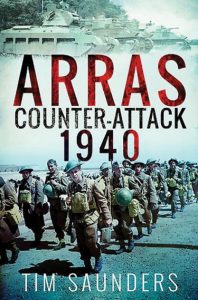 Arras Counter-Attack 1940 (Tim Saunders, Pen and Sword Books, South Yorkshire, UK, 2019, 204 pp., maps, photographs, appendices, index, $19.95, softcover)
Arras Counter-Attack 1940 (Tim Saunders, Pen and Sword Books, South Yorkshire, UK, 2019, 204 pp., maps, photographs, appendices, index, $19.95, softcover)
On May 21, 1940, as the Battle of France raged on and the Allied situation grew steadily worse, the British Expeditionary Force began an operation to help secure the city of Arras. Two tank regiments led the way, and despite poor coordination they struck deep into the flank of the 7th Panzer Division. The well-armored Matilda tanks stood against the German antitank guns and sowed destruction among the enemy infantry. Unfortunately, the British infantry lagged behind, so this success could not be exploited. However, when General Erwin Rommel arrived on the scene he used his characteristic energy and personal leadership to restore the situation, despite being covered in the brains of his dead aide-de-camp, killed standing next to him. Even so, Rommel later said he fought off an attack by five divisions.
This well-organized book begins with the prewar origins of the British armored force and expertly covers the expansion of the army as war loomed. With this interesting prelude, the author then dives into the battle, giving the reader a soldier’s view of the action. While it stands well as a history, the book is also intended as a tour book to be used on a visit to the battlefield. As such it is well supplied with useful maps and illustrations.
 The Secret South: A Tale of Operation Tabarin 1943-46 (Ivan MacKenzie Lamb, Greenhill Books, South Yorkshire, UK, 2019, 304 pp., maps, photographs, notes, bibliography, index, $39.95, hardcover)
The Secret South: A Tale of Operation Tabarin 1943-46 (Ivan MacKenzie Lamb, Greenhill Books, South Yorkshire, UK, 2019, 304 pp., maps, photographs, notes, bibliography, index, $39.95, hardcover)
Few today know anything of Operation Tabarin. Launched in 1943, it was a secret wartime expedition to the Antarctic. There, British operatives established covert bases with the intent to monitor German and Japanese activities and keep out the Argentinians, who sought to seize control of territory while Great Britain was distracted by World War II. The mission was so successful it evolved into the postwar British Antarctic Survey, an important research program. It also helped pave the way for the Falklands War decades later.
The author was Operation Tabarin’s botanist, and this work is a newly published edition of his diary. He helped establish the bases used by the expedition and took part in three major sledging operations. The book provides fascinating insight into an unknown but important sideshow during the war and uses contemporary photographs and maps to tell the story.
 New and Noteworthy
New and Noteworthy
Death March Escape: The Remarkable Story of a Man Who Twice Escaped the Nazi Holocaust (Jack J. Hersch, Pen and Sword Books, 2019, $34.95, hardcover) Dave Hersch was a Hungarian Jew who was shipped to Mauthausen concentration camp in 1944. He later escaped two death marches to another camp and managed to survive the war.
Left for Dead at Nijmegen: The True Story of an American Paratrooper (Marcus Nannini, Casemate Books, 2019, $32.95, hardcover) Gene Metcalfe parachuted into Holland as part of Operation Market Garden. Captured, he survived a harrowing ordeal, including a meeting with Heinrich Himmler.
Pacific Thunder: The US Navy’s Central Pacific Campaign, August 1943-October 1944 (Thomas McKelvey Cleaver, Osprey Publishing, 2019, $18.00, softcover) This far-ranging naval campaign ended with the U.S. Navy dominant across the world’s largest ocean. The author expertly recounts how this happened.
Red Sniper on the Eastern Front (Edited by Sergey Anisimov, Pen and Sword Books, 2019, $22.95, softcover) Joseph Pilyushin killed 136 Nazis and trained 380 fellow snipers during World War II. These are his memoirs.
USN Fleet Destroyer vs. IJN Fleet Submarine: The Pacific 1941-42 (Mark Stille, Osprey Publishing, 2019, $20.00, softcover) This comparison of naval forces shows the effectiveness of the Japanese undersea arm in the early part of the war as the Americans learned how to combat them.
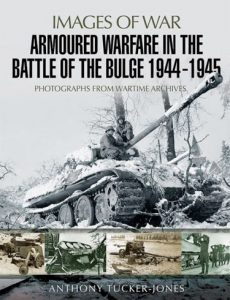 Armored Warfare in the Battle of the Bulge 1944-1945 (Anthony Tucker-Jones, Pen and Sword Books, 2019, $24.05, softcover) The Ardennes fighting involved the last major tank engagements in Western Europe during the war. This photo book vividly reveals the action.
Armored Warfare in the Battle of the Bulge 1944-1945 (Anthony Tucker-Jones, Pen and Sword Books, 2019, $24.05, softcover) The Ardennes fighting involved the last major tank engagements in Western Europe during the war. This photo book vividly reveals the action.
6th SS Mountain Division Nord at War 1941-1945 (Ian Baxter, Pen and Sword Books, 2019, $24.95, softcover) This storied division fought from the Arctic Circle to eastern France. The images in the photo book document that history.
JU-88 Aces of World War II (Robert Forsyth, Osprey Publishing, 2019, $24.00, softcover) Originally designed as a bomber, the fast JU-88 was easily adapted as a fighter. Many of those who flew it had great success against Allied bomber attacks on Germany.
Tiger I and Tiger II Tanks (Dennis Oliver, Pen and Sword Books, 2019, $22.95, softcover) This book covers the last battle of the Tiger tank units in Western Europe during 1945. It also contains extensive information on building models of these vehicles.
Shot Down and in the Drink: True Stories of RAF and Commonwealth Aircrews Saved from the Sea in World War II (Graham Pitchfork, Osprey Publishing, 2018, $15.00, softcover) This is a fascinating account of air-sea rescue during the war. It covers situations from different theaters of the war.
